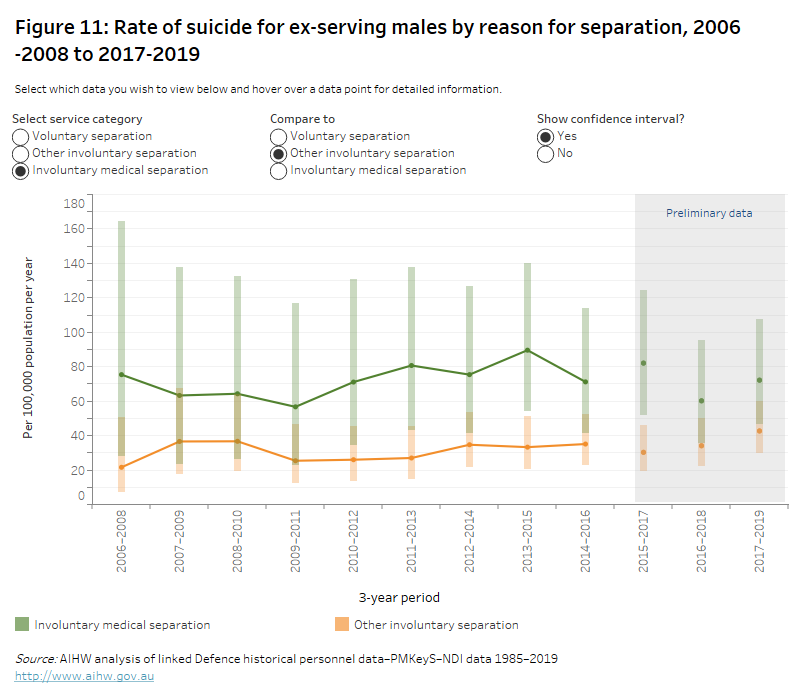Suicides by reason for separation
The reasons that ADF members separate from the ADF can be categorised into three broad groups:
- voluntary separation
- other involuntary separation
- involuntary medical separation.
The separation point used in this report reflects full separation from the ADF, that is, when a member is no longer permanent or reserve. Separation reason is therefore the reason recorded for leaving the last engagement with the ADF.
Due to a change in the way the reason for separating the ADF was recorded in 2002, analysis is presently only reported for ADF members who separated from 1 January 2003 onwards. These members comprise 40% of the total ex-serving members with at least 1 day of service since 1 January 1985.
The most common reason for separation from the ADF was voluntary separation with the proportions similar for males and females at 44.8% and 44.7 respectively. This was followed by other involuntary reasons (males 31.0% and females 24.6%) and involuntary medical reasons (males 14.0% and females 17.1%).
Between 2003 and 2019, the suicide rate for ex-serving males by reason for separation was lowest for those who separated voluntarily (22.2 per 100,000 population per year) and highest for those whose reason for separation was involuntary medical (73.1 per 100,000 population per year). In addition ex-serving males who separated voluntarily from the ADF have a similar rate of suicide as the Australian males (22.4 compared to 22.2 per 100,000 population per year)
| Reason for separation(a) | Ex-serving males: Suicide rate per 100,000 population per year |
Ex-serving females: |
|---|---|---|
|
Voluntary separation |
22.2 |
20.6 |
|
Total involuntary(b) |
44.2 |
17.3 |
|
Other involuntary separation |
33.8 |
n.p. |
|
Involuntary medical separation |
73.1 |
n.p. |
Notes
n.p. Not available for publication but included in totals where applicable, unless otherwise indicated.
- Due to a change in the way the reasons for separating the ADF was recorded during 2002, analysis is presented only for ADF members who left from 1 January 2003 onwards. These members comprise 40% of the total ex-serving members with at least 1 day of service since 1 January 1985.
- The Total involuntary group was used for ex-serving females because further disaggregation was not possible due to small number of suicide deaths.
Source: AIHW analysis of linked Defence historical personnel data–PMKeyS–NDI data 1985–2019.
Figure 9: Suicide rates by reason for separation, ex-serving males, 2003–2019
Source: AIHW analysis of linked Defence historical personnel data-PMKeyS–NDI data 1985–2019.
Between 2003 and 2019, the suicide rates for ex-serving females by reason for separation were similar for voluntary separation and involuntary separation (20.6 and 17.3 per 100,000 population per year respectively).
Due to small numbers for ex-serving females, other involuntary and involuntary medical separation reasons have been aggregated as total involuntary separation.
Figure 10: Suicide rates by reason for separation, ex-serving females, 2003–2019
Note: (a) The Total involuntary group was used for ex-serving females because further disaggregation was not possible due to small number of suicide deaths.
Source: AIHW analysis of linked Defence historical personnel data-PMKeyS–NDI data 1985–2019.
Suicide rate by reason for separation over time
The following graphs show suicide rates by reason for separation over time for ex-serving males.
Due to the number of suicide deaths among ex-serving females, suicide rates by reason for separation over time are not reported.
The interactive graph below presents the suicide rates for ex-serving males in each of the reason for separation groups, for all 3-year periods from 2006-2008 to 2017-2019.

Note: The confidence intervals in this figure can be used to determine the significance of differences between the suicide rates calculated for the ex-serving population within a given 3-year period. However, they cannot be used to determine the significance of differences between rates calculated for the ex-serving population for overlapping 3-year time periods (for example 2002–2004 and 2003–2005).
Data underlying this graph are available in Supplementary table S6.7 See Data for a link to the tables.
Please note, data for more recent years are subject to change; see Technical notes for further detail.
If you need help or support, please contact:
Open Arms - Veterans and Families Counselling 1800 011 046
Open Arms Suicide Intervention page
Defence All-hours Support Line (ASL) 1800 628 036
Defence Member and Family Helpline 1800 624 608
Defence Chaplaincy Support 1300 333 362
Lifeline 13 11 14
Suicide Call Back Service 1300 659 467
Beyond Blue Support Service 1300 22 4636
For information on support provided by DVA, see:


